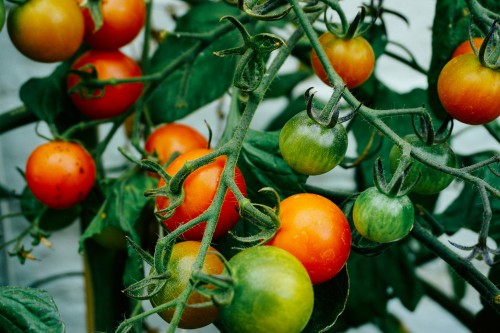Tomato
A Complete Guide to growing Tomatoes in the UK
Introduction
Tomatoes are one of the most rewarding crops for UK gardeners. With their vibrant colour, versatility in the kitchen, and potential for heavy yields, they’re a favourite from allotments to windowsills. While tomatoes thrive in warmer climates, with the right methods—whether growing from seed, buying young plants, or choosing container-friendly varieties—they can perform beautifully in British conditions. Success depends on choosing the right type, providing warmth and sun, and keeping up with watering and feeding.
Types and Timing
Tomatoes fall into two main categories:
Cordon (indeterminate): Tall-growing, trained up canes or strings, producing trusses of fruit over a long season.
Bush (determinate): Compact, often suitable for pots and hanging baskets, producing a flush of fruit over a shorter period.
Cherry and plum types: Popular for snacking, salads, and sauces.
Timing:
Sow seeds indoors from late February to April.
Buy young plants from April onwards.
Move plants outside (greenhouse, pots, or growbags) after the last frost—usually late May or early June in most of the UK.
Succession sowing every few weeks in early spring ensures a longer harvest window.
Site and Soil Requirements
Tomatoes demand warmth and sun:
Light: At least 6–8 hours of direct sun. A south-facing spot is ideal.
Soil: Fertile, free-draining, and enriched with organic matter or well-rotted compost.
Containers: Growbags, large pots (30cm+), or hanging baskets for bush varieties. Use peat-free multipurpose compost with added slow-release fertiliser.
Shelter: Outdoor tomatoes benefit from a warm wall or cloche to extend the season.
Propagation & Planting
Sowing indoors: Sow seeds in small pots or trays 0.5 cm deep. Keep at 18–21°C. Germination usually takes 7–14 days.
Pricking out: Once seedlings have true leaves, move to individual modules or small pots.
Potting on: Transplant to larger pots as they grow, keeping stems deep to encourage strong rooting.
Hardening off: Acclimatise plants by moving them outdoors for longer periods each day over 7–10 days.
Final planting: Space cordon tomatoes 45 cm apart; bush types can be closer depending on variety.
Growing & Maintenance
Watering: Keep soil consistently moist—avoid cycles of drought and flood which cause splitting. Water at the base, not the leaves.
Feeding: Use a high-potash feed (e.g., tomato fertiliser) weekly once the first flowers set.
Staking & training: Support cordon tomatoes with canes or strings. Pinch out side-shoots weekly. Bush types need minimal training.
Pruning: Remove yellowing leaves near the base to improve air circulation.
Mulching: Helps retain moisture and reduce weeds.
Greenhouse ventilation: Prevents fungal disease and improves pollination.
Harvest and Post-Harvest
Timing: Tomatoes are ready when fully coloured and slightly soft to the touch. This usually begins from July onwards.
Harvesting: Pick regularly to encourage further fruiting.
Ripening off the plant: Place underripe fruits on a sunny windowsill or in a paper bag with a banana.
Storage: Eat fresh for best flavour. Store at room temperature, not in the fridge, to preserve taste.
Preservation: Surplus can be made into sauces, passata, or chutneys.
Troubleshooting & Pests
Blight: A serious fungal disease in damp summers. Grow resistant varieties or use greenhouse cover. Remove affected plants promptly.
Blossom end rot: Black patches on fruit caused by irregular watering and calcium deficiency. Maintain steady watering.
Greenback: Hard, green shoulders due to poor light or temperature stress. Pick varieties bred for resistance.
Pests: Watch for aphids, whitefly, and red spider mite (indoors). Use biological controls or soap sprays.
Poor fruit set: Tap flowers or shake plants to aid pollination, especially under cover.
Why do tomatoes split?: This can be caused by varying water supply as well as fluctuating temperatures. Also, it's a common problem with the Sun Gold variety - which is why you won't see them in stores. They are still fine to eat but it's best to eat/cook them quickly.
Tips from Growers / FAQs
Best for beginners: Try bush types like ‘Tumbling Tom’ or reliable cordons like ‘Moneymaker’.
Regional notes: In northern UK, stick to greenhouse growing or early varieties. In the south, outdoor crops usually thrive.
Pinching out tops: Stop cordon plants after 5–6 trusses have set to focus energy on ripening.
Green tomato recipes: Don’t waste unripe fruit—use them for chutneys or fry them.
Resources & References
© What to plant 2025. All rights reserved
